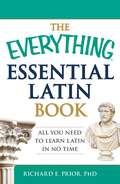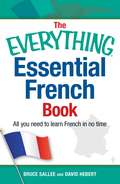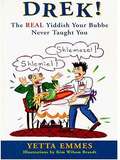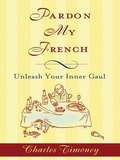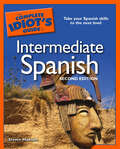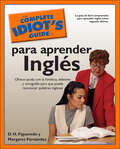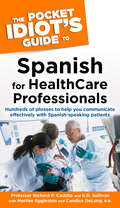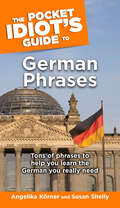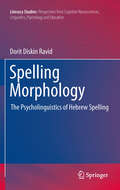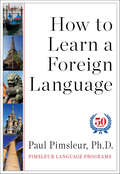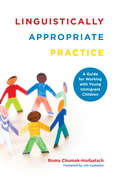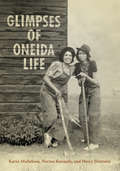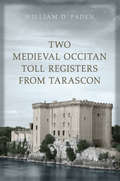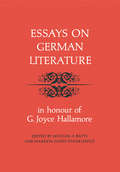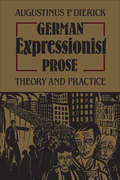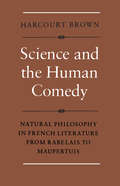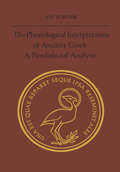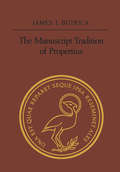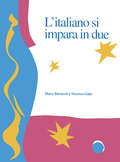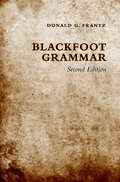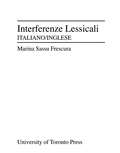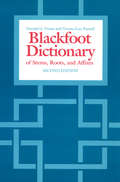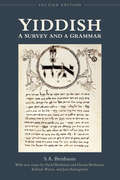- Table View
- List View
The Everything Essential Latin Book
by Richard E. PriorThe basics of Latin made fun--and fast! Learning the basics of Latin can vastly improve your vocabulary and even provide keys to understanding legal, medical, and scientific terminology. The Everything Essential Latin Book is your perfect introduction to this fascinating language. With easy-to-follow instructions and simple explanations, this portable guide covers the most important basics of Latin, including: The Roman alphabet and translation The all-important syntax of Latin Getting someone's attention and giving commands Common questions and answers Describing people and places Verb tenses Grammatical voice With The Everything Essential Latin Book, you'll be speaking like an ancient Roman in no time!
The Everything Essential Latin Book: All You Need to Learn Latin in No Time
by Richard E PriorThe basics of Latin made fun--and fast!Learning the basics of Latin can vastly improve your vocabulary and even provide keys to understanding legal, medical, and scientific terminology. The Everything Essential Latin Book is your perfect introduction to this fascinating language. With easy-to-follow instructions and simple explanations, this portable guide covers the most important basics of Latin, including:The Roman alphabet and translationThe all-important syntax of LatinGetting someone's attention and giving commandsCommon questions and answersDescribing people and placesVerb tensesGrammatical voiceWith The Everything Essential Latin Book, you'll be speaking like an ancient Roman in no time!
The Everything Essential French Book: All You Need to Learn French in No Time (The Everything Books)
by Bruce Sallee David HebertAll the basics of French--fast and easy!Whether you are planning a vacation, adding a valuable second language to your resume, or simply brushing up on your skills, The Everything Essential French Book is your perfect introduction to the French language. With easy-to-follow instructions and simple explanations, this portable guide covers the most important basics, including:The French alphabet, accents, and translation.Common French phrases and greetings.Everyday questions and answers.Verb tenses and sentence structure.How to place an order and give commands.The Everything Essential French Book has all you need to get from bonjour to au revoir in no time!
Drek!: The Real Yiddish Your Bubbe Never Taught You
by Yetta Emmes Kim Wilson BrandtOne doesn't have to be Jewish to recognize the words that have made their way into every fold of popular language: Chutzpah, Mensch, Tokhes, Mishmash, Nudge, Shtick, Schmaltzy, Schlep, Icky, and so on. Then there are phrases whose meaning and syntax are borrowed from Yiddish: "bite your tongue", "drop dead", "enough already", and "excuse the expression". This hilarious, concise guide includes chapters on the Basic Descriptions of People (the good, the bad, the ugly, and the goofy), the Fine Art of Cursing, Juicy Words and Phrases, Exclamations and Exasperations, and the Fine Art of Blessing. .
Pardon My French
by Charles TimoneyTHINGS YOU DIDN'T KNOW ABOUT FRANCE : How to say Oh la la Smuggling live chickens into rugby matches is patriotic How many times to kiss on the cheek A six-pack is a bar of chocolate The dangers of being called Peter or Penny Ordering a steak without getting sneered at The importance of Wednesdays How to tip When to celebrate Christmas From sugar-cube etiquette to why the Marseillaise is all about slaughtering Austrians and Prussians as bloodily as possible, Charles Timoney lays bare the Gallic mindset alongside their bizarre language. Covering all areas of everyday life from eating and drinking to travel, work and, crucially, swearing and sounding like a teenager, this is not just the most entertaining, but also the most useful book on France and the French you'll ever read.
The Complete Idiot's Guide to Intermediate Spanish, 2nd Edition: Take Your Spanish Skills to the Next Level
by Steven HawsonThis revised edition offers expanded coverage of grammar and vocabulary, as well as idiomatic usage, irregular verbs, and conversational elements that will help readers improve their language skills in a variety of situations. In addition, a new workbook section specially designed to help readers practice and retain information has been included.• Includes a comprehensive review of beginning Spanish, plus simple strategies for memorizing cases, endings, and vocabulary• Features an easy-to-understand guide to Spanish idioms• Covers business and medical Spanish• Techniques for mastering vocabulary and grammar• New exercises and answers throughout
The Complete Idiot's Guide to Para Aprender Ingles
by D.H. Figueredo Margaret FernandezMillions of Spanish-speaking immigrants enroll in ESL (English as a Second Language) classes every year. This curriculum-based guide offers practical examples, exercises, and quizzes to quickly and effectively bolster English skills.
The Pocket Idiot's Guide to Spanish For Health Care Professionals
by K.D. Sullivan Prof. Richard P. CastilloFor health workers serving a growing community. Today, when one in four babies born in the US is Hispanic, it is essential that every hospital administrator, nurse, EMT, and doctor have a working knowledge of Spanish. Chapters include vocabulary, phrases, and pronunciation for everything from insurance forms to mental health to prenatal care, with additional sections on dentistry and optometry. • Essential reference for doctors, nurses, EMTs, nursing home staff, home caregivers, volunteers, hospice nurses, and administrators. • Perfect size for a lab coat pocket. • Author is an experienced linguist with experience in teaching health care–related Spanish courses.
The Pocket Idiot's Guide to German Phrases: Tons of Phrases to Help You Learn the German You Really Need
by Angelika Korner Susan ShellySprechen Sie Deutsch? You do now! The Pocket Idiot&’s Guide® to German Phrases is a handy, informative, and fun guide to all the phrases readers need to enjoy a visit to Germany, complete with the basics of German grammar and syntax and a compact German-English/English-German dictionary. • Nearly 1.7 million Americans travel to Germany each year for business and/or leisure—and most will find this book invaluable. • Full of current and classic phrases from every aspect of life and travel, along with useful travel tips and maps. • Easy-to-use pronunciation guide and verb, noun, and idiom charts. • Convenient, pocket-size format for on-the-go travelers.
Spelling Morphology
by Dorit Diskin RavidModern Hebrew is a highly synthetic Semitic language--its lexicon is rich in morphemes. This volume supplies the first in-depth psycholinguistic analysis of the interaction between morphological knowledge and spelling in Hebrew. It also examines how far this model can be applied to other languages. Anchored to a connectionist, cognitive, cross-linguistic and typological framework, the study accords with today's perception of spelling as being much more than a mere technical skill. Contemporary psycholinguistic literature views spelling as a window on what people know about words and their structure. The strong correlation between orthographies and morphological units makes linking consistent grammatical and lexical representation and spelling units in speaker-writers a key research goal. Hebrew's wealth of morphological structures, reflected in its written form, promotes morphological perception and strategies in those who speak and write it, adding vitality and relevance to this work.
How to Learn a Foreign Language
by Paul PimsleurIn this entertaining and groundbreaking book, Dr. Paul Pimsleur, creator of the renowned Pimsleur Method, the world leader in audio-based language learning, shows how anyone can learn to speak a foreign language.If learning a language in high school left you bruised, with a sense that there was no way you can learn another language, How to Learn a Foreign Language will restore your sense of hope. In simple, straightforward terms, Dr. Pimsleur will help you learn grammar (seamlessly), vocabulary, and how to practice pronunciation (and come out sounding like a native). The key is the simplicity and directness of Pimsleur’s approach to a daunting subject, breaking it down piece by piece, demystifying the process along the way. Dr. Pimsleur draws on his own language learning trials and tribulations offering practical advice for overcoming the obstacles so many of us face.Originally published in 1980, How to Learn a Foreign Language is now available on the 50th anniversary of Dr. Pimsleur’s publication of the first of his first audio courses that embodied the concepts and methods found here. It's a fascinating glimpse into the inner workings of the mind of this amazing pioneer of language learning.
Linguistically Appropriate Practice: A Guide For Working With Young Immigrant Children
by Roma Chumak-HorbatschThis path-breaking book provides a convincing argument for the importance of children's home languages and the benefits of dual- and multi-language learning. A new classroom practice known as Linguistically Appropriate Practice (LAP) offers guidance for those working with young children who arrive in childcare centres and schools with little or no proficiency in the classroom language. Linguistically Appropriate Practice details over fifty classroom activities that can be adapted to match both the developmental level of the children and the classroom curriculum. Intended for childcare staff, health care providers, settlement workers, speech and language pathologists, kindergarten and primary grade teachers, family resource workers, and literacy specialists, this book is an essential resource for preparing young children for the complex communication and literacy demands of the twenty-first century.
Glimpses of Oneida Life
by Norma Kennedy Karin Michelson Mercy A. DoxtatorGlimpses of Oneida Life is a remarkable compilation of modern stories of community life at the Oneida Nation of the Thames Settlement and the surrounding area. With topics ranging from work experiences and Oneida customs to pranks, humorous encounters, and ghost stories, these fifty-two unscripted narrations and conversations in Oneida represent a rare collection of first-hand Iroquoian reflections on aspects of daily life and culture not found in print elsewhere.Each text is presented in Oneida with both an interlinear, word-by-word translation and a more colloquial translation in English. The book also contains a grammatical sketch of the Oneida language by Karin Michelson, co-author of the Oneida-English/English-Oneida Dictionary, that describes how words are structured and combined into larger linguistic structures, thus allowing Glimpses to be used as a teaching text as well.The engrossing tales in Glimpses of Oneida Life will be a valuable resource for linguists and language learners, a useful source for those studying the history and culture of Iroquois people in the twentieth-century, and an entertaining read for anyone interested in everyday First Nations life in southern Ontario.
Two Medieval Occitan Toll Registers from Tarascon
by William D. PadenTwo Medieval Toll Registers from Tarascon presents an edition, translation, and discussion of two vernacular toll registers from fourteenth and fifteenth-century Provence. These two registers are a valuable new source for the economic, linguistic, and transportation history of medieval France, offering a window onto the commercial life of Tarascon, a fortified town on the east bank of the Rhône between Avignon and Arles. William D. Paden discusses the developing fiscal policy of the counts of Provence, for whom the tolls were collected, and the practice and vocabulary of medieval toll-keeping. An afterword considers the toll registers in relation to the poetry of troubadours, arguing that the realism of the registers and the idealism of troubadour poetry overlapped in the world of medieval Tarascon.
Essays on German Literature: In Honour of G. Joyce Hallamore
by Michael S. Batts Marketa Goetz StankiewiczThe present Festschrift serves a dual purpose: firstly, to honour Professor Joyce Hallamore for her contribution to German studies in Canada, particularly at the University of British Columbia; secondly, to document the flourishing state of German studies in this country. Former and present students of Professor Hallamore were asked to contribute essays from their varied fields of interest which she has stimulated and fostered; furthermore, colleagues across Canada were invited to contribute the results of their research: the broad theme of this second group of essays is the complex relationship between nineteenth and twentieth century literature which has been the centre of Professor Hallamore's own scholarly work.<P><P> This volume commemorates Professor Hallamore's forty years of scholarship and teaching--the time given by her to the University of British Columbia, not only to the formation and growth of the Department of German (which she has headed for some twenty years) but to the expansion of the University as a whole. It demonstrates at the same time through breadth and variety the coming of age of German studies in Canada, which Professor Hallamore has fostered.<P>Although the essays in this volume vary in approach, the result shows a remarkable harmony of outlook, which gives evidence of the authors' conscious effort to reconsider critically traditional categories and attitudes in literary criticism. This harmony of outlook--found in the whole range of papers from the youngest to the most mature scholar--reflects the spirit and work of the person whom the volume is honouring.
German Expressionist Prose: Theory and Practice
by Augustinus DierickAn extreme sensitivity to gathering social crisis, an accompanying angry enthusiasm for artistic experimentation and renewal – this compelling mix in German art, poetry, and drama of the period 1910 to 1925 continues to draw both scholarly attention and intense popular interest. In this book Augustinus Dierick focuses on another significant but hitherto neglected medium of German Expressionist thought – short narrative prose – in order to illuminate and evaluate the contribution of that genre to one of the twentieth century's most powerful artistic movements. Dierick's study includes a thorough analysis of the works of a broad range of Expressionist prose writers, from those of such specialists in the genre as Edschmid, Heym, Benn, Loerke, Frank, Sternheim, Ehrenstein, and 'Mynona' to the shorter prose works of such major figures as Alfred Döblin, Heinrich Mann, Max Brod, and Franz Werfel. Dierick isolates the thematic obsessions common among Expressionist writers: the pathos of the self in confrontation with nature and with God, the tension between self and the institutions of bourgeois society, and the attractions and dangers of eroticism. Throughout Dierick stresses the interrelationship between themes and their formal expression. He examines many apparent excesses in style and tone, many aberrations in structure and generic characteristics, and identifies them not as needless experimentation but as a necessary result of the attempt to find appropriate forms for extreme situations and complex ideas. Dierick's analysis makes clear that Expressionist prose has an intrinsic artistic value and, because of certain nuances and different accents, must be included in any estimation of the nature and importance of Expressionism as a whole.
Science and the Human Comedy: Natural Philosophy in French Literature from Rabelais to Maupertuis
by Harcourt BrownNew scientific theories, methods, and objectives exert subtle and often unnoticed influences on literary creation. The developments of the attitudes and aspirations of French scientists between the Renaissance and the Revolution and the impact of these new outlooks on French literature form the theme of this book by an authority in the interdisciplinary treatment of science and literature. Implicit in the author's exploration is the view that in the development of the scientific revolution there was no overall design, but rather random growth; human beings turn up at various moments, some of them appropriately, some of them not, so that the record is in part a story of successful endeavour, in part a comedy little short of farce. in the historical panorama of this book, four auhors, each known for his ironic, even comic, insight into the human condition, are chosen to illustrate the theme. As men of letters, Rabelais and Voltaire exhibit well-defined scientific interests, while Pascal and Maupertuis were drawn from their scientific vocations into the discussion of ideas in literary forms. Consideration of their similarities and differences suggested the title, Science and the Human Comedy. This work is a valuable contribution to our understanding of the historical and cultural conditions accompanying the advancement of science in a critical period, as well as of several ways in which the process was reflected, sometimes directly, more often indirectly, in literature. (University of Toronto Romance Series 30)
Phonological Interpretation of Ancient Greek, The: A Pandialectal Analysis
by Vit BubenikThis volume treats systematically the variation found in the successive stages of the development of all ancient Greek dialects. It combines synchronic approach, in which generative rules expound phonological divergencies between the systems of different dialects, with a diachronic statement of unproductive and mostly pan-Hellenic shifts.Professor Bubeník presents a phonetic description and structural phonemic analysis of the best-known variant--Classical Attic of the 5th century B.C.--and displays and contrasts the vocalic and consonantal inventories of all the other dialects classified according to their major groups. Derivational histories of individual dialects are examined in their juxtaposition, to ascertain which rules are shared by various dialects and which are dialect-specific. The pandialectal framework enables Bubeník to capture various relationships among genetically related dialects which are missed in atomistic and static treatments, and to show more convincingly the extent of their similarity and their systemic cohesion.This volume makes a significant contribution to both classical scholarship and current theory of language change by offering new analyses of a variety of phonological and morphophonemic problems presented by a dead language and its dialects.
The Manuscript Tradition of Propertius
by The Estate of James ButricaThe elegist Sextus Propertius (ca 50-ca 16 BC) is generally reckoned among the most difficult of Latin authors. At the root of this difficulty lies a deeply corrupt text and uncertainty over the manuscript transmission; moreover, the manuscripts used in the standard editions of today have been selected without a comprehensive examination of the surviving copies. This study, the fullest survey of the manuscripts so far, considers the affiliation of more than 140 complete or partial witnesses and offers a thorough reassessment of the tradition. The principal novelty is the argument that six Renaissance copies represent an independent third witness to the archetype, revealing passages where corruptions, glosses, or medieval corrections are now accepted as the words of Propertius and suggesting that the archetype was far more corrupt than now commonly supposed. The study is in two parts. In Part One, after a survey of Propertius' fortuna in the Middle Ages, the author considers the affiliation and history of the known manuscripts and editions to 1502, then offers a text and revised apparatus of four elegies; in Part Two he presents detailed descriptions of 143 manuscripts, most of them from personal inspection.
L'italiano si impara in due
by Marco Barsacchi Vincenzo GattoThis workbook offers the teacher of Italian a varied collection of activities for the classroom. The thirty-one activities involve situations and guided exercises for creating dialogues, exchanging information, providing descriptions, and completing questionnaires and forms. In L?italiano si impara in due students work in pairs. The situations and contexts are typical of Italian society, combining topics of interest to contemporary Italian youth with traditional elements of Italian culture. The book is intended for beginner and intermediate students as a means of integrating and complementing a basic course of study. In each unit, grammatical structures are introduced and developed, as is vocabulary. Interaction between students is ensured by the complementary, two-part composition of the text. An exhaustive glossary that includes all idiomatic expressions and jargon used in the activities completes the book.
Blackfoot Grammar
by Donald G. FrantzThousands of people in Alberta and Montana speak Blackfoot, an Algonquian language. But the numbers are diminishing and the survival of Blackfoot is in some danger. To help preserve the language while it is still in daily use, Donald G. Frantz and Norma Jean Russell collaborated on the Blackfoot Dictionary, published in 1989 to widespread acclaim and later revised in 1995. Blackfoot Grammar, the companion volume to the dictionary, has now also been updated with a second edition. The changes made to each chapter reflect new approaches refined through years of teaching experience. New chapters on 'Numbers and Enumeration' and 'Translating from English to Blackfoot' have been added, as well as new exercises and two new appendixes describing the phonetics of Blackfoot and the design of the alphabet.This second edition of Blackfoot Grammar will be a welcome update not only for those who wish to learn the language, but for all those with an interest in Native Studies and North American linguistics.
Interferenze lessicali
by Marina Sassu FrescuraThis workbook deal with lexical interference in Italian and English ? the problem of 'false cognates,' words in one language that resemble words in another language but have different meanings. Aimed at correcting and preventing the most common errors caused by lexical interference and at expanding the student's vocabulary, it is intended for use by students with on or two years' training in Italian in high schools, universities, and community colleges. The workbook contains exercises on specific interferences, twelve recapitulation exercises, a section on interferences of lower frequency, and a set of exercises on which the student can work independently.
The Blackfoot Dictionary of Stems, Roots, and Affixes
by Donald G. Frantz Norma Jean RussellThis second edition of the critically acclaimed dictionary originally published in 1989 adds more than 300 new entries and amplifies over 1000 others. The Blackfoot Dictionary is a comprehensive guide to the vocabulary of Blackfoot, an Algonquian language spoken by thousands in Alberta and Montana. It contains more than 4,000 Blackfoot-English entries and an English index of more than 5,000 entries, and provides thorough coverage of cultural terms. The transcription uses an official, technically accurate alphabet and the authors have classified entries and selected examples based on more than 25 years of research.
Yiddish: A Survey and a Grammar, Second Edition
by Kalman Weiser Eleazar Birnbaum S. A. Birnbaum David Birnbaum Jean BaumgartenOne of the great Yiddish scholars of the twentieth century, S.A. Birnbaum (1891-1989) published Yiddish: A Survey and a Grammar in 1979 towards the end of a long and prolific career. Unlike other grammars and study guides for English speakers, Yiddish: A Survey and a Grammar fully describes the Southern Yiddish dialect and pronunciation used today by most native speakers, while also taking into account Northern Yiddish and Standard Yiddish, associated with secularist and academic circles. The book also includes specimens of Yiddish prose and poetic texts spanning eight centuries, sampling Yiddish literature from the medieval to modern eras across its vast European geographic expanse.The second edition of Yiddish: A Survey and a Grammar makes this classic text available again to students, teachers, and Yiddish-speakers alike. Featuring three new introductory essays by noted Yiddish scholars, a corrected version of the text, and an expanded and updated bibliography, this book is essential reading for any serious student of Yiddish and its culture.
Williams Hebrew Syntax (3rd Edition)
by John C. BeckmanAlthough the morphology and lexicon of Hebrew are reasonably well understood, its syntax has long been a neglected area of study. Syntax, the relationship of words to one another, forms, together with morphology, the material of grammar. Its relative importance varies according to the language considered. This is particularly true of word order, for when an inflected language loses its case endings, word order assumes many of the functions of the former cases. <P><P> This outline by Professor Williams re-emphasizes the significance of word order in Hebrew. Developed over fifteen years in a formal course on Hebrew syntax at the University of Toronto, it treats the syntax of the noun, the verb, particles and clauses, with a selection of illustrative examples. Its contents are based on classical Hebrew prose, but some account is also taken of the deviations in later prose and poetry. In this new edition English translations have been provided for all Hebrew phrases and sentences, and the bibliography has been expanded.<P> Advisory: Bookshare has learned that this book offers only partial accessibility. We have kept it in the collection because it is useful for some of our members. To explore further access options with us, please contact us through the Book Quality link on the right sidebar. Benetech is actively working on projects to improve accessibility issues such as these.
